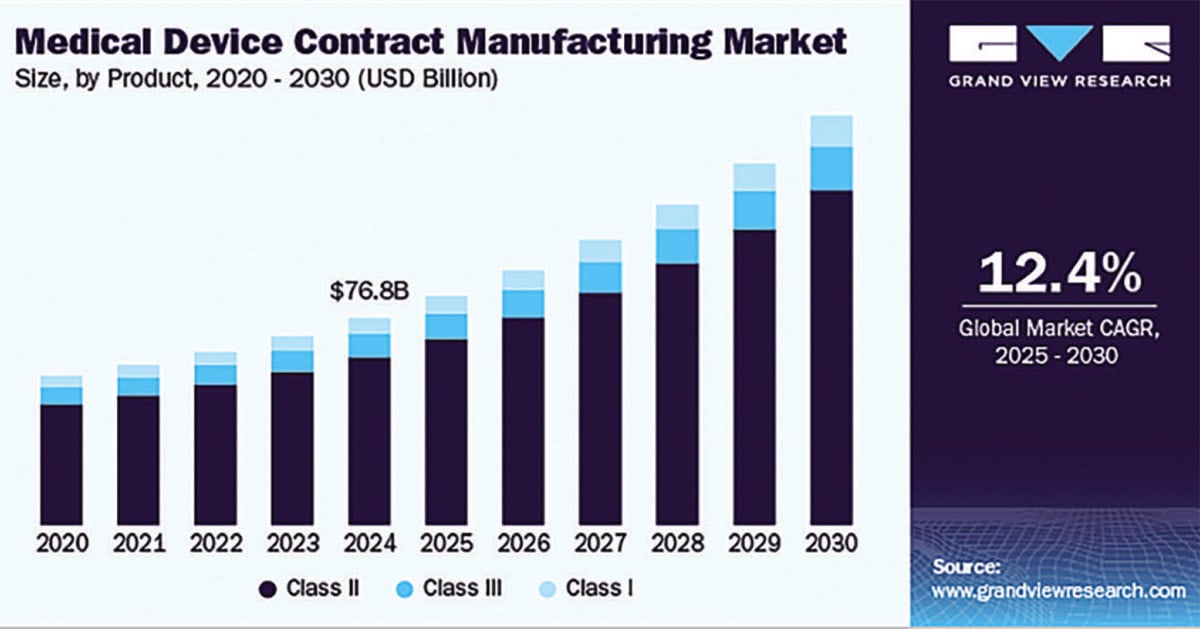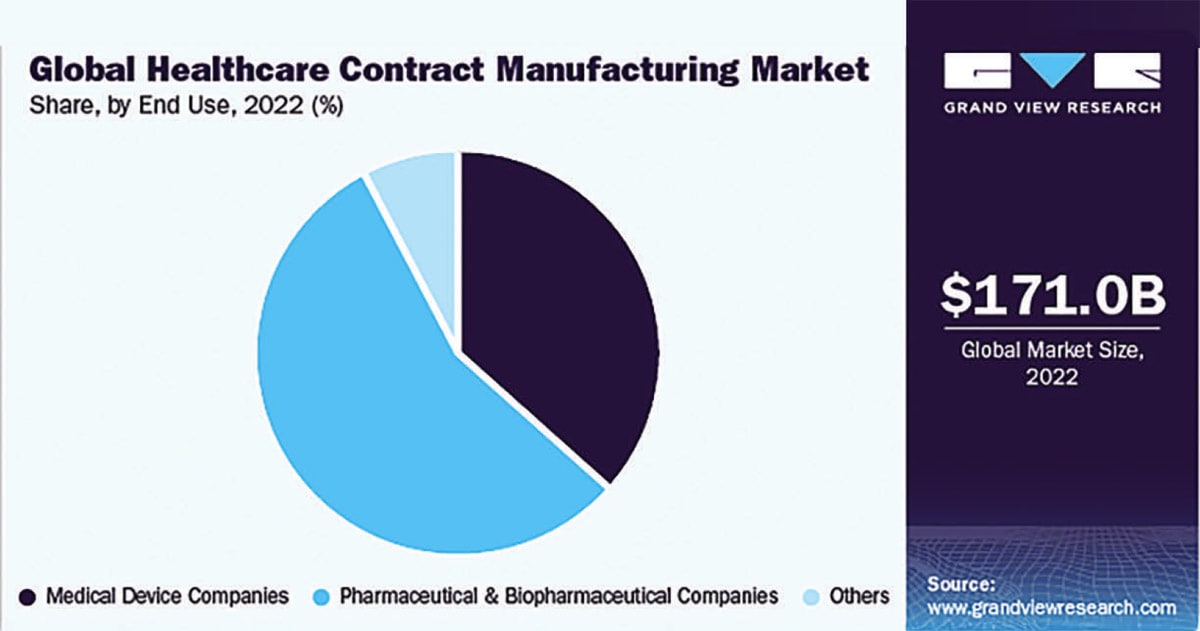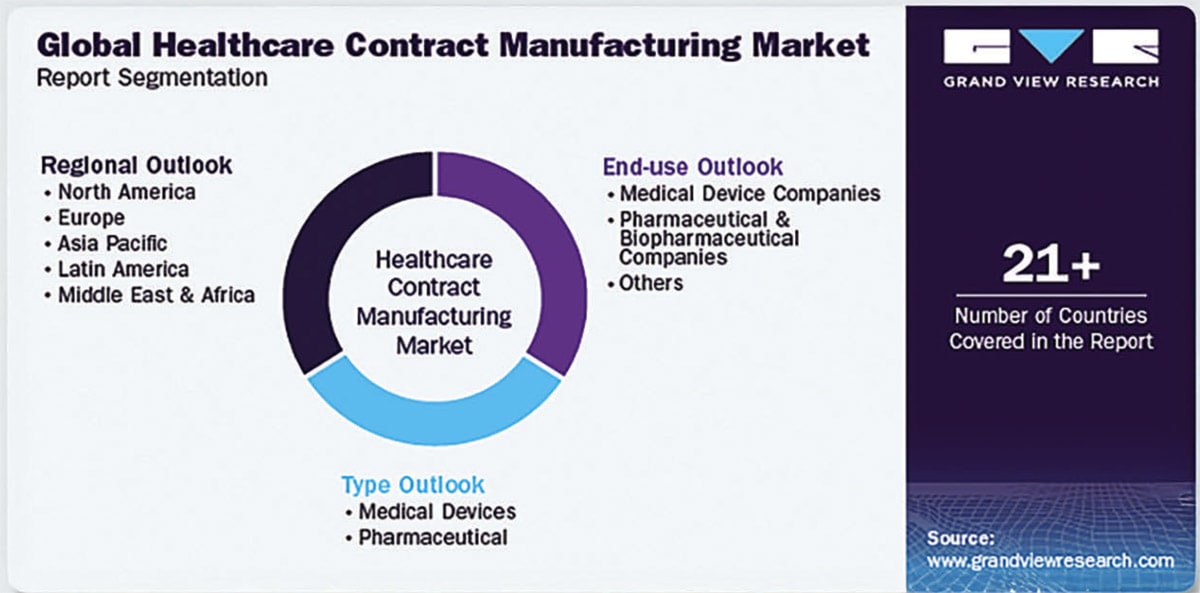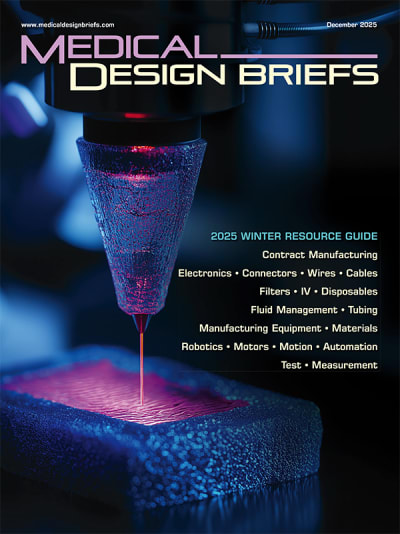
The medical device contract manufacturing industry is experiencing significant growth, driven by technological advancements, an aging global population, and increasing healthcare demands. With a market size of $76.8 billion in 2024, the industry is expected to nearly double by 2030, reaching $151.98 billion at a CAGR of 12.36 percent. The U.S. market alone generated $16.7 billion in 2024 and is projected to reach $32.9 billion by 2030. As medical device companies continue to outsource production to specialized contract manufacturers, key trends such as automation, additive manufacturing, and regulatory compliance are shaping the industry’s future. 1
Contract manufacturing has emerged as a crucial driver of efficiency, cost reduction, and innovation. Companies are increasingly relying on specialized manufacturers to meet rising demand while navigating complex regulatory landscapes and technological advancements. To understand the full scope of the industry’s rapid expansion, this article presents key statistics that highlight its current market size, growth projections, regional trends, and emerging opportunities.

Market Size and Growth
Global Market. The global medical device contract manufacturing market is set to nearly double in size, growing from $76.8 billion in 2024 to an estimated $151.98 billion by 2030. This substantial growth, at a CAGR of 12.36 percent, reflects the increasing shift by medical device companies to outsource production in order to lower costs, improve efficiency, and focus on innovation. The complexity of modern medical devices — such as minimally invasive surgical tools, advanced imaging systems, and next-generation drug-delivery devices — requires specialized manufacturing capabilities that contract manufacturers are uniquely positioned to provide. 1
Additionally, as regulations tighten worldwide, OEMs prefer to work with contract manufacturers that have established regulatory expertise, robust quality control systems, and scalable operations. The expected market expansion suggests that companies investing in automation, precision engineering, and high-quality materials will have a competitive edge.

U.S. Market. With the U.S. medical device contract manufacturing market projected to grow from $16.7 billion in 2024 to $32.9 billion by 2030, the country remains one of the most important hubs for medical technology development and production. The 12.3 percent CAGR highlights strong demand for contract manufacturing, particularly as OEMs seek partners to navigate stringent FDA regulations, accelerate time-to-market, and reduce overhead costs. The U.S. market is also benefiting from reshoring trends, as companies look to mitigate supply chain risks, enhance quality assurance, and leverage domestic production incentives. Another key driver is the expanding digital health sector, where wearable devices, remote monitoring tools, and AI-powered diagnostics are fueling demand for highly precise and scalable manufacturing solutions. Contract manufacturers with expertise in microelectronics, miniaturization, and integration with digital health platforms are well positioned to capture market share. 2
Market Drivers

Aging Population. The aging population is a major catalyst for the expansion of the medical device contract manufacturing industry. By 2050, the global population aged 60 and older is expected to reach 2.1 billion, up from 1 billion in 2020, according to the United Nations. This demographic shift has resulted in a growing need for implantable devices (such as pacemakers, orthopedic implants, and neurostimulators), diagnostic tools, and long-term monitoring solutions.
The prevalence of chronic conditions such as cardiovascular diseases, diabetes, and arthritis has further increased demand for high-precision, patient-specific medical devices. 3 Contract manufacturers are responding by adopting advanced materials, customized 3D printing technologies, and robotic automation to enhance device quality and accessibility. Additionally, the push toward home healthcare and personalized medicine is expanding the market for portable medical devices, providing further growth opportunities for contract manufacturers specializing in compact, user-friendly designs.
Technological Advancements. The medical device contract manufacturing sector is being transformed by cutting-edge technologies such as Industry 4.0, artificial intelligence (AI), automation, and additive manufacturing. These advancements are transforming how medical devices are designed, prototyped, and produced. Additive manufacturing(3D printing) allows for rapid prototyping, customization of patient-specific implants, and cost-efficient low-volume production. AI-powered quality control systems improve defect detection and enhance consistency in high-precision medical components.
At the same time, robotics and automation are driving efficiency in assembly, reducing labor costs, and improving manufacturing accuracy. The rise of smart manufacturing and real-time production monitoring is enabling contract manufacturers to offer greater transparency, improved compliance tracking, and reduced turnaround times. As regulatory requirements continue to evolve, investment in these technologies will be crucial for maintaining competitive differentiation in the market.
Regional Insights

Asia Pacific. Asia Pacific is emerging as the fastest-growing region in the medical device contract manufacturing industry, driven by rising healthcare investments, lower production costs, and government-backed initiatives aimed at strengthening domestic medical device production. Countries such as China, India, Singapore, and Malaysia are positioning themselves as key players in the global supply chain, offering cost-effective alternatives to North American and European manufacturers. China, in particular, has seen significant growth in its medtech sector, with contract manufacturers investing in automation, quality control, and advanced material sciences to cater to international markets. 3

India is also becoming a hub for low-cost, high-quality medical device manufacturing, with government initiatives such as “Make in India” promoting local production and regulatory streamlining. Additionally, rising disposable incomes in Asian countries are increasing demand for affordable, locally produced medical devices, prompting multinational companies to establish partnerships with regional contract manufacturers. However, challenges such as intellectual property protection, regulatory variability, and supply chain bottlenecks remain key factors that companies must navigate to fully capitalize on the region’s growth potential.
Product Segmentation
Class II Devices. Class II medical devices represent the largest share of the contract manufacturing market, accounting for 81.25 percent of global revenue in 2024. This segment includes a diverse range of medium-risk devices, such as diagnostic imaging systems, infusion pumps, catheters, and blood glucose monitors. The dominance of Class II devices can be attributed to their widespread use in hospitals, outpatient facilities, and home healthcare settings, as well as the relatively moderate regulatory requirements compared to Class III devices. 1
Wearables. One of the most notable trends within this category is the rise of wearable and remote patient monitoring devices, which are increasingly integrated with smartphone apps, cloud-based data storage, and AI-powered analytics. As the global healthcare system shifts toward preventive care and remote patient management, contract manufacturers specializing in miniaturization, IoT integration, and wireless communication technologies are experiencing high demand. The market for disposable medical devices, such as single-use diagnostic tools and drug-delivery systems, is also expanding, particularly in response to infection control concerns post-pandemic.
Healthcare Contract Manufacturing
The broader healthcare contract manufacturing industry, which encompasses pharmaceuticals, biologics, diagnostics, and medical devices, is projected to grow from $171 billion in 2022 to $347.5 billion by 2030, at a CAGR of 9.5 percent. This steady growth reflects the increasing reliance of pharmaceutical and medtech companies on outsourcing to reduce costs, improve scalability, and access specialized expertise. 1
Within this space, medical devices represent one of the most rapidly expanding subsectors, fueled by the rise of connected healthcare, personalized medicine, and biologics-based drug-delivery systems. Innovations such as bioresorbable implants, robotic-assisted surgery devices, and AI-driven diagnostic tools are driving contract manufacturers to invest in high-precision engineering, cleanroom manufacturing, and regulatory compliance capabilities. Consolidation of contract manufacturers is accelerating, with major players acquiring smaller firms to expand their capabilities in automation, material sciences, and drug-device combination products. As medical devices become increasingly sophisticated and integrated with digital health ecosystems, contract manufacturers must focus on cross-disciplinary expertise in software, electronics, and material innovation to remain competitive.
Conclusion
Medical device contract manufacturing is poised for robust and sustained growth, with the global market projected to surpass $150 billion by 2030. This expansion is being driven by technological innovations, shifting healthcare demands, and increasing reliance on outsourcing to improve efficiency and cost-effectiveness. Companies investing in smart manufacturing, automation, and regulatory expertise will be best positioned to capitalize on these trends.
As Class II devices, home healthcare solutions, and wearable technology gain traction, contract manufacturers must prioritize scalability, digital integration, and compliance with evolving global regulations. With strong growth expected across Asia Pacific, North America, and Europe, the future of medical device contract manufacturing is defined by innovation, strategic partnerships, and a commitment to high-quality production.
This article is based on reports from Grand View Research. For more information, visit here .
References
- “Medical Device Contract Manufacturing Market Size, Share & Trends Analysis Report By Product (Class I, Class II, Class III), By Services, By Therapeutic Area, By End-use, By Region, And Segment Forecasts, 2025 – 2030,” Grand View Research.
- “U.S. medical device contract manufacturing market, 2018-2030 (US$M),” Horizon Grand View Research.
- “Medical Device Contract Manufacturing Market by Device Type (IVD, Cardiovascular, Drug Delivery (Autoinjectors, Infusion Device), Diabetes Care, Orthopedic, Ophthalmology, Endoscopy, Surgical), Device Class (I, II, III), Services & Region – Global Forecast to 2029,” Markets and Markets.



